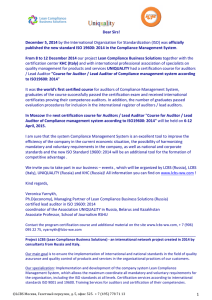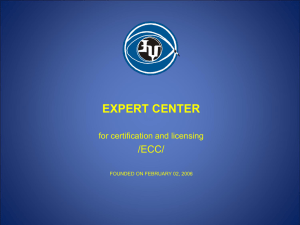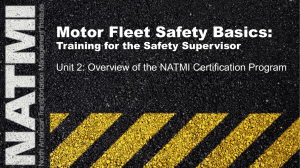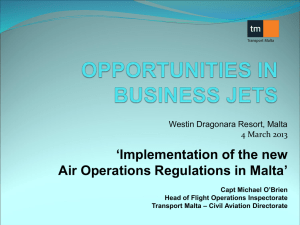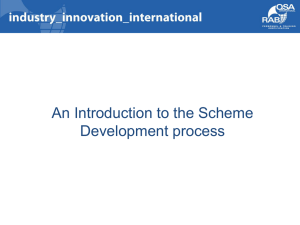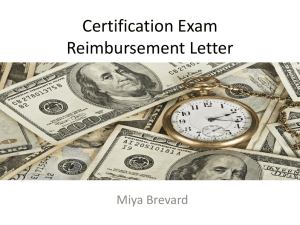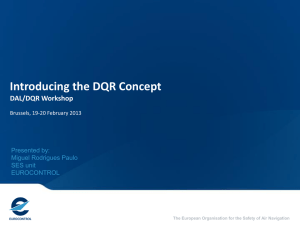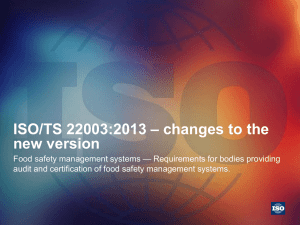here - IRCA
advertisement
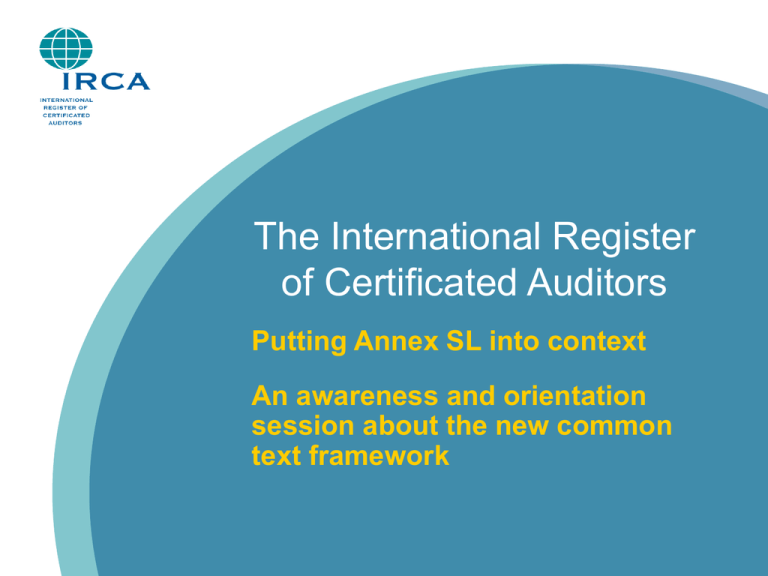
The International Register of Certificated Auditors Putting Annex SL into context An awareness and orientation session about the new common text framework Delivered by: Max Linnemann IRCA Certification Manager What this session will cover: • • • • • What is Annex SL – A brief explanation Why has it been created? First reason for it’s creation (in brief) Second reason for it’s creation (in brief) Summary of identified changes in comparison with current edition of ISO 9001/ISO 14001. • • Putting Annex SL into context The use of management system standards – some comments on influencing factors for consideration. Exposing and understanding Annex SL How will Annex SL affect business? How will Annex SL affect certification? Conclusions • • • • Annex SL (Appendix 2) A framework for all ISO management system standards (MSS) providing: • high level structure (HLS) • identical subclause titles • identical text • common terms and core definitions Why was Annex SL created? 1. To create a common text framework, which will be easier for organisations to utilise and for auditors to audit against. 2. To improve the effectiveness, and value of management system standards generally by being more holistic. Summary of key changes identified in Annex SL 4. Context of the Organisation 4.1 – Understanding the organisation and its context. (Note also the reference to internal and external issues) 4.2 – Understand the needs and expectations of interested parties. 4.3 – Determining the scope of the XXX management system. 5. Leadership. This is a change in term, as it was previously ‘Management responsibility’. Note: ensuring that the XXX policy and XXX objectives are established and are compatible with the strategic direction of the organization directing and supporting persons to contribute to the effectiveness of the XXX management system 6. Planning 6.1 Actions to address risks and opportunities Also of note here is the absence of ‘preventive action’. 7. Support. This section seems to have grouped a number of clauses. For example: 'responsibility and authority and communication' and 'resource management'. Most notable change is in relation to documentation. The requirements are very light. There is no requirement for documented procedures of any kind. 9001, 14001 may contain additional requirements of course – but we already know from the draft of ISO 9001:2015, that it does not include any additional requirements here. So, this is a significant change. 8. Operation This section is just a good example of how the current versions of the standards do not align well. If you are more familiar with ISO 14001, then you might be thinking 4.4.6 - Operational control. If you are more familiar with ISO 9001, then you might be thinking about "Clause 7 (7.1 Planning of product realisation, right through to – 7.5.5 Preservation of produce)". So, a bit of a reorganisation and standardisation of clauses and terms. As an example of how scheme specific clauses will be incorporated, in 14001 I could foresee "Emergency planning and response" being included here. 9. Performance Evaluation 10. Improvement The content of both of these sections is largely familiar. The use of Management System Standards Standards are produced for businesses to use and benefit from. Organisations that embrace management systems benefit from them. But there are organisations that just want the certificate. • The Management System is a superficial overlay. • The Management System is seen as a pain • Disconnect between Senior Management and Management System The superficial adoption of management systems devalues management systems globally. Certification • Whilst the standards are written for business, and not for auditors, certification is a very important area, directly tied to the utilisation of management systems. • The value of certification can therefore directly impact on the actual value and perceived value of management system standards. • There is pressure on the Certification bodies to accept ‘superficial adoption’ of the management system standards, as it is a very competitive market. Auditor Competence • Wrapped up within the Certification elements is ‘auditor competence’. This has been a topic of increasing prevalence, and ISO 17021:2011 highlights that it is has been considered an area that needed to be addressed. • Poor auditors devalue certification, which in turn devalues management system standards. • But ISO is not in control or involved with prescribing what auditor competence is. That is all up to the Certification Bodies and Accreditation Bodies – or is it? Siloed approach • Due to standards being produced separately, and with different structures and different terminology, ISO has perhaps, historically, promoted the thinking that management systems are independent from one another. • In reality a business has one management system. The ‘business management system’. Exposing Annex SL A lot of the changes noted earlier, such as ‘context of the organisation’ and internal and external issues, and interested parties, and leadership and risks and opportunities are actually all linked. These clauses are insisting that the management system is not held at arms length. They very neatly tie the management system to the strategic direction of the business, to the senior management of the business, and require that the business ‘orientates’ itself effectively. Annex SL is raising the standards into the board room Annex SL is aligning standards with the needs of business. General approach (not siloed), considering MS in relation to business more holistically. Light documented requirements Development in 9001 – as examples. Trying to restrict limited scopes How will it affect Business? • For organisations that embrace the management system standards, there will be likely very little effect. • Annex SL puts pressure on organisations that take a superficial approach and perhaps are only ‘interested in the certificate’. • The clauses have made it less easy to hold the system at arm’s length and put pressure on the organisation to utilise the standards the way that they were originally intended. How will it affect Certification? • If we accept that currently, there are a lot of auditors that are adding little value to organisations because they are conducting ‘eyes down’, tick list like audits, then what we can say is ‘we’ve got a competence gap’. • Auditors may need to be more business minded and experienced with management in order to provide business with value. Annex SL places pressure on the certification bodies to reconsider ‘what an acceptable scope or boundary of a management system is’ as the standards will require a more holistic approach, that should make it more difficult to have very deliberately limited scopes. Certification Bodies may not want to change anything, as the changes may make in more difficult to issue certificates to organisations doing a superficial job if implementation. Certification bodies should consider their context currently, and the ‘risks and opportunities’ that exist to them. With that information, determine whether there may be any advantage in proactively tackling the issues presented here, to position themselves as a the market leader in this regard. Conclusions • Annex SL is a lot more than just a common framework for Management System Standards. • The new Clauses are intending to align standards with business. • The new clauses intend to help stop the devaluing of management system standards through superficial adoption, low level auditing and meaningless certification. • Annex SL, will require an increase in auditor competence, if certification is to be seen to be beneficial to business. Thank you for listening.

